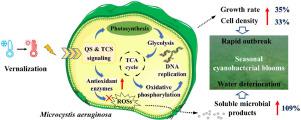Water Research ( IF 11.4 ) Pub Date : 2022-08-06 , DOI: 10.1016/j.watres.2022.118956 Hao Ming 1 , Ge Yan 1 , Xue Zhang 1 , Xiaofen Pei 1 , Liang Fu 1 , Dandan Zhou 1

|
Cyanobacterial blooms are seasonal phenomena in eutrophic water. Cyanobacteria grow fast in the warm spring/summer while disappearing in cold autumn/winter. The temperature change induces algal vernalization. However, whether vernalization affects cyanobacterial blooms, and the regulatory signaling mechanisms are unclear. This study used Microcystis aeruginosa as the model cyanobacteria, and 4 °C and 10 °C as the low-temperature stimulation to explore the cell growth, metabolites, and signaling pathways in cyanobacteria vernalization. Low temperatures induced M. aeruginosa vernalization; the growth rate and cell density increased by 35±4% and 33±2%. Vernalization influenced peptidoglycan synthesis and cell permeability. Soluble microbial products (SMPs) in water increased by 109±5%, resulting in water deterioration. Polysaccharides were the predominant SMPs during the initial term of vernalization. Tryptophan protein-like & humic acid-like substances became the main increased SMPs in the middle-later period of vernalization. Harsh temperatures triggered quorum sensing and two-component system. Signaling sensing systems upregulated photosynthesis, glycolysis, TCA cycle, oxidative phosphorylation, and DNA replication, enhancing M. aeruginosa growth and metabolism during vernalization. This study verified that low temperature stimulates cyanobacteria growth and metabolism, and vernalization possibly aggravates cyanobacterial blooms and water deterioration. It provides new insights into the mechanism of seasonal cyanobacterial blooms and the pivotal role of signaling regulation.
中文翻译:

严酷的温度诱导铜绿微囊藻生长增强和春化过程中的水质恶化
蓝藻水华是富营养化水中的季节性现象。蓝藻在温暖的春夏快速生长,而在寒冷的秋冬消失。温度变化诱导藻类春化。然而,春化是否会影响蓝藻水华,其调控信号机制尚不清楚。本研究以铜绿微囊藻为蓝藻模型,以4°C和10°C为低温刺激,探索蓝藻春化过程中的细胞生长、代谢物和信号通路。低温诱导绿脓杆菌春化; 生长速度和细胞密度分别增加了 35±4% 和 33±2%。春化影响肽聚糖合成和细胞通透性。水中的可溶性微生物产物(SMPs)增加了 109±5%,导致水变质。在春化初期,多糖是主要的 SMP。类色氨酸蛋白和类腐植酸类物质成为春化中后期增加的主要SMPs。恶劣的温度触发了群体感应和双组件系统。信号传感系统上调光合作用、糖酵解、TCA 循环、氧化磷酸化和 DNA 复制,增强绿脓杆菌春化过程中的生长和代谢。本研究证实低温刺激蓝藻生长和代谢,春化可能加剧蓝藻水华和水质恶化。它为季节性蓝藻水华的机制和信号调节的关键作用提供了新的见解。











































 京公网安备 11010802027423号
京公网安备 11010802027423号